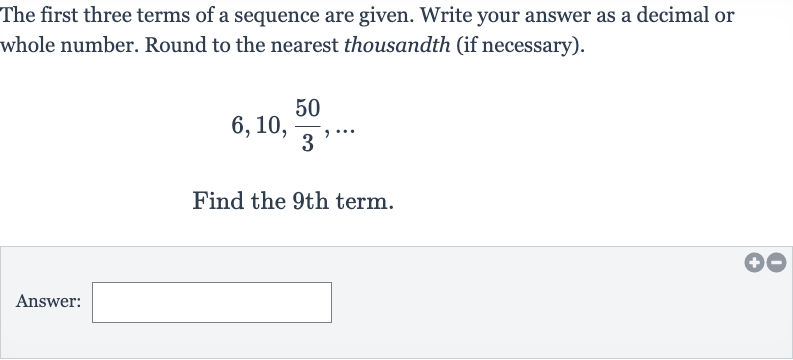AI tutor
Welcome to Bytelearn!
Let’s check out your problem:

The first three terms of a sequence are given. Write your answer as a decimal or whole number. Round to the nearest thousandth (if necessary).Find the th term.Answer:
Full solution
Q. The first three terms of a sequence are given. Write your answer as a decimal or whole number. Round to the nearest thousandth (if necessary).Find the th term.Answer:
- Identify Pattern: Identify the pattern in the sequence.The given sequence is To find the pattern, we need to look at the differences or ratios between the terms. Let's check the differences first.Difference between second and first term: Difference between third and second term: The differences are not constant, so this is not an arithmetic sequence. Let's check if it's a geometric sequence by finding the ratios.Ratio of second to first term: Ratio of third to second term: The ratios are constant, so this is a geometric sequence with a common ratio of .
- Use Formula for th Term: Use the formula for the nth term of a geometric sequence to find the th term.The formula for the nth term of a geometric sequence is , where is the first term, is the common ratio, and is the term number.Here, (the first term), (the common ratio), and (since we're looking for the th term).Let's plug these values into the formula:$a_9 = \(6\) \times \left(\frac{\(5\)}{\(3\)}\right)^\(8\)
- Calculate \(9\)th Term: Calculate the \(9\)th term. \(\newline\)\(a_9 = 6 \times \left(\frac{5}{3}\right)^8\)\(\newline\)To simplify this, we can calculate \(\left(\frac{5}{3}\right)^8\) first and then multiply by \(6\).\(\newline\)\(\left(\frac{5}{3}\right)^8 = \frac{5^8}{3^8}\)\(\newline\)\(= \frac{390625}{6561}\)\(\newline\)Now, multiply this by \(6\):\(\newline\)\(a_9 = 6 \times \left(\frac{390625}{6561}\right)\)\(\newline\)\(a_9 = \frac{2343750}{6561}\)
- Simplify Fraction: Simplify the fraction to get the decimal value. \(\newline\)\(a_9 = \frac{2343750}{6561}\)\(\newline\)To get the decimal value, we divide \(2343750\) by \(6561\).\(\newline\)\(a_9 \approx 357.210\)\(\newline\)Since we need to round to the nearest thousandth, the \(9\)th term is approximately \(357.210\).
More problems from Find trigonometric functions using a calculator
QuestionGet tutor help
QuestionGet tutor help
QuestionGet tutor help
QuestionGet tutor help
QuestionGet tutor help
QuestionGet tutor help
Question
. Find the value of in degrees.Write your answer in simplified, rationalized form. Do not round.____
Get tutor helpQuestionGet tutor help
